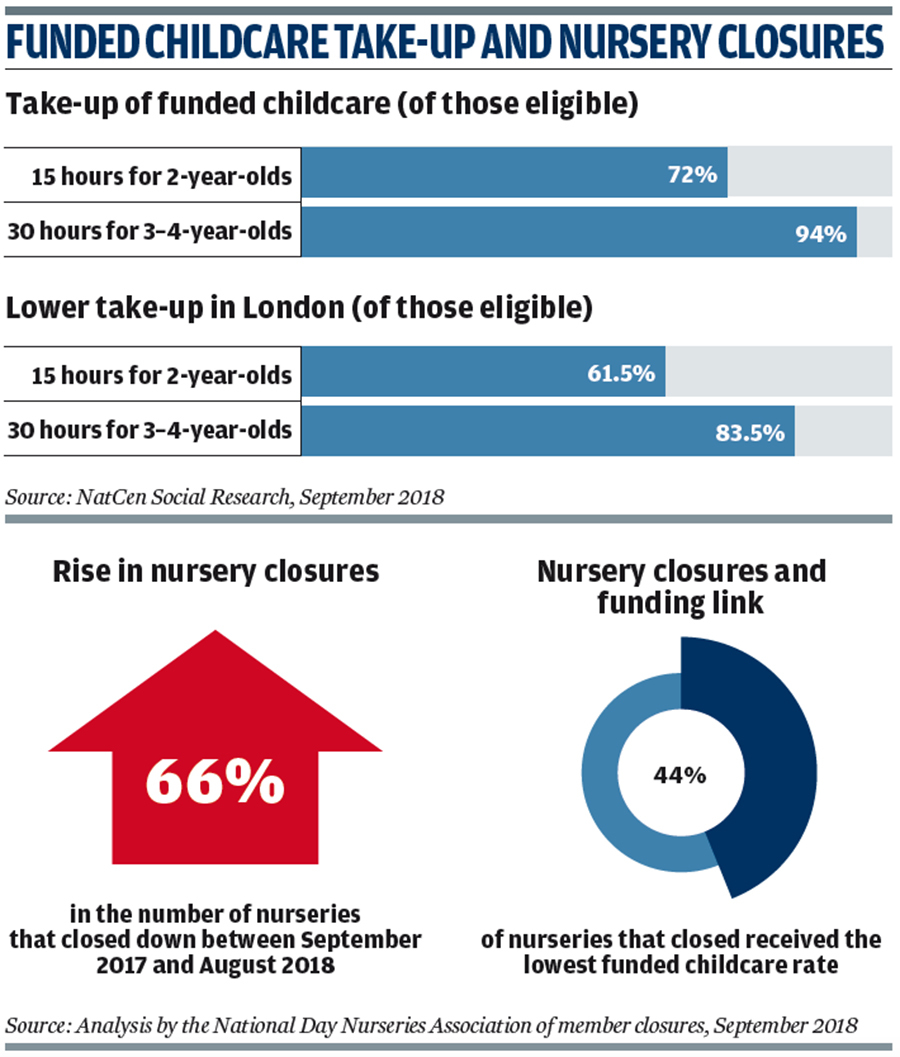Focus on 30 hours limits places for disadvantaged two-year-olds
Derren Hayes
Tuesday, September 25, 2018
Research shows take-up of funded childcare for disadvantaged two-year-olds lags far behind that of three- and four-year-olds. Providers say insufficient funding makes it uneconomical to create two-year-old places.

A number of reports published last month have highlighted the possible detrimental impact that 30 hours of government-funded childcare is having on the early years sector.
The separate studies have been seized upon by early years organisations and leaders as further proof that 30 hours is not backed with sufficient government funding. This, they say, is hurting providers financially, which in turn is reducing availability of childcare places for disadvantaged children.
In September 2013, two-year-olds living in the 20 per cent most disadvantaged households were entitlement to 15 hours of government-funded childcare per week for a total of 38 weeks of the year. A year later, the offer was extended to two-year-olds living in the 40 per cent most deprived families.
A recent NatCen Social Research report on funded early education entitlements found that in 2018, 72 per cent of eligible disadvantaged two-year-olds took up their 15 hours funded childcare entitlement across England.
In comparison, the take-up rate for the 30 hours of funded childcare for three- and four-year-olds is 94 per cent of those eligible.
Regional variation
It also found significant regional variation in take-up rates. For example, in the North West, take-up is 83 per cent of eligible two-year-olds, whereas in inner London, it falls to just 60 per cent.
Experts say this regional variation is due to a number of reasons, including the higher cost of premises and staff salaries in London and parts of the South East (see expert view).
Lower take-up rates for the two-year-old entitlement could be as a result of there being insufficient places to meet demand. Research by Harding et al in 2017 found that, on average, just 32 per cent of councils in the South East reported having sufficient places, compared with 70 per cent in the North West.
In the qualitative research for the NatCen study, London and non-London authorities with different levels of take-up typically reported experiencing greater difficulties achieving sufficiency for two-year-olds than three- and four-year-olds.
Commissioned by the Department for Education and based on analysis of government data and interviews with council early years leads, childcare providers and parents, the NatCen report found that providers were reluctant to create two-year-old places because of the higher costs of delivering it compared to provision for older children.
Greater needs
Providers told researchers that disadvantaged two-year-olds - who include those in care and from low-income families - have greater needs, which are more costly to meet. For example, staff to child ratio for looking after two-year-olds is 1:4, but the ratio for three year olds is between 1:8 and 1:13, depending in the qualifications of the worker.
"Across the board, there was evidence from providers that two-year-old places were less financially lucrative due to the higher staffing ratios, the need for more space and the higher needs of the children eligible for the entitlement and their families," states the report.
"These factors led to reluctance among some providers of all types to offer places to two-year-olds."
The National Day Nurseries Association (NDNA) says its own research shows that more than half of its members make a loss on funded places for two-year-olds because funding from government does not meet providers' costs.
Nurseries that close down and cancel their NDNA membership are increasingly citing underfunding of the free entitlement as the cause (see graphic).

Financial pressures
The pressure on childcare providers' finances was illustrated by separate research by Frontier Economics and the University of East London, which found four in 10 providers had seen profits hit since the introduction of the 30-hour offer.
NDNA chief executive Purnima Tanuku says: "Successive reports have shown that the funding rate is not covering providers' costs, particularly for private, voluntary and independent nurseries which provide the vast majority of funded places.
"If more of these nurseries fold or continue to limit places to survive, there won't be sufficient places for the childcare policy to work."
A Pre-school Learning Alliance survey found one in five childcare providers said the number of funded places they offered had fallen as a result of the introduction of 30 hours.
Neil Leitch, alliance chief executive, says: "With providers struggling to make ends meet, especially in light of 30 hours, accessing two-year-old places is going to get harder until funding rates are reviewed.
"Until there's enough money in the system, providers worried about their sustainability will have little choice but to take on children with fewer associated costs. That means the children who most need childcare going without."
However, James Hempsall, national programme director for Childcare Works, says the fact that the take-up for the two-year-old offer is at its highest level ever "should be celebrated, not least because it makes such an enormous difference to least advantaged families".
"Take-up at 72 per cent represents a tremendous achievement by providers and local authorities for an optional programme targeted at the least advantaged families," he adds.
The number of two-year-olds taking up funded places has risen from 86,640 in 2014 to 163,250 in 2017. However, Hempsall admits that engaging families of eligible two-year-olds is "not easy".
"It takes effort, patience and a nuanced approach to raise parental awareness, while supporting take-up through encouragement and motivation," he says. "There remains a cohort of parents that benefit from a more intensive engagement from family facing professionals or indeed other parents - this takes time, resource and effort, which seems in short supply in some areas."
Rising demand
Hempsall says that as the 30-hour entitlement becomes more embedded, he expects demand for places to rise further, presenting providers with an additional challenge "as settings again consider their delivery and financial models, seeking out ways to make it work".
He says in these circumstances, it will be crucial for local authorities to support providers to create sufficient places to meet rising demand and to help parents to take up their funded childcare entitlements (see box).
"There is no doubt to me that providers are a dedicated group of social entrepreneurs; organisations that want the best for the children and families they work with, including least advantaged children, and are focused on sustaining their businesses and their workforces for the future," he adds.
Expert view
More funding and better quality childcare would improve take-up of two-year-old offer in london
By June O'Sullivan, chief executive, London Early Years Foundation (LEYF)
According to the findings from the NatCen report about the factors associated with the take-up rate of the funded entitlements, London has the lowest take-up. As a large London provider, I am not surprised.
LEYF is a social business with a social mission to operate in a way that supports disadvantaged children. In some boroughs, we offer the highest proportion of places for those two-year-olds entitled to the "free" offer. However, it's a real struggle because of the costs of providing the places. It is therefore unsurprising that the take-up is 60 per cent against a national average of 72 per cent.
London is an expensive city. It is more difficult to provide a higher cost service. Ratios for two year olds are higher and we continue to struggle to recruit and retain good staff. This is a phase of development that merits well trained empathetic and effective teachers. Not everyone can teach two-year olds - especially those on the programme as so many have additional learning and family needs.
In one of our nurseries that is sited in a poor neighbourhood, of all the children who started this term, over one-third are already showing concerning levels of need from child protection to significant communication issues. This is quite another level from the usual development challenges.
Add this to the increase in rents - in some nurseries up to 100 per cent, and this is from social landlords like local authorities, housing associations and charities - it's not surprising that London is slow on the take-up.
So, what are we to do in London?
The report also looked at parents' motivations for sending their children to nursery and many have a trust issue or are concerned about quality. This was higher among black and minority ethnic parents of which there are a higher number entitled to the free offer living in London. They have a point. Ceeda research found that the gap between children from disadvantaged families and their peers is widening, and the quality of nurseries in poor neighbourhoods is also of concern. Children in deprived areas are 19 per cent likely to attend an outstanding nursery compared with 25 per cent of those in more affluent areas.
The local authorities' children's services are much diminished and the process of allocating placements for two-year-olds is clumsy - that could be improved too. However, London needs an uplift against real costs and a campaign that explains why children aged two will benefit from nursery education and what quality looks like in nurseries.
SUPPORT FOR PROVIDERS
James Hempsall outlines five key roles for councils to ensure they have sufficient childcare places:
- Build awareness of, and provide information on, the entitlements for parents
- Support and enable professionals to broker use of all funded entitlement
- Bring providers together to discuss and share experiences of delivery, including changes made, solutions found, successes achieved, and lessons learned
- Offer effective business advice and support to help providers' sustainability and quality delivery
- Ensure an equal focus on all entitlements: universal 15 hours, two-year-olds, and 30 hours




